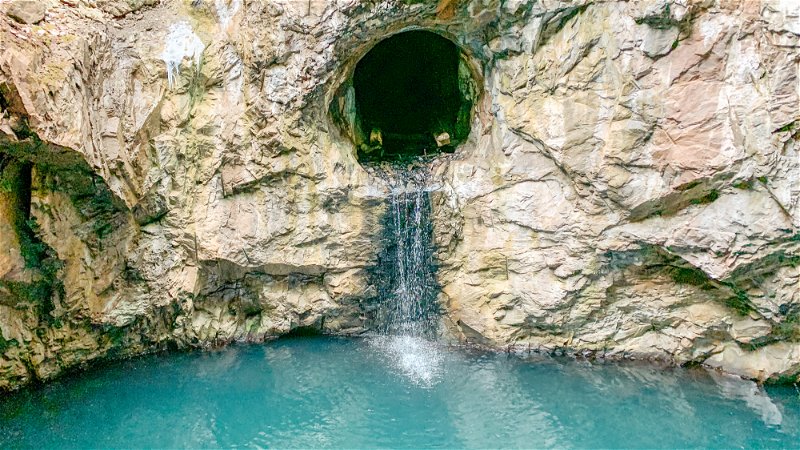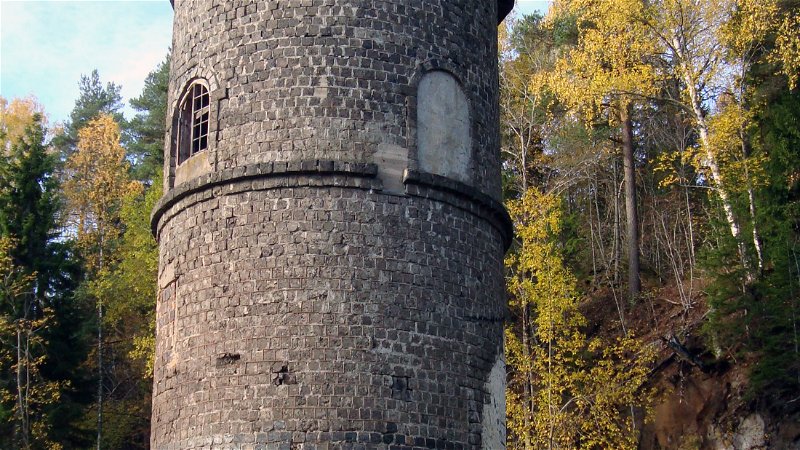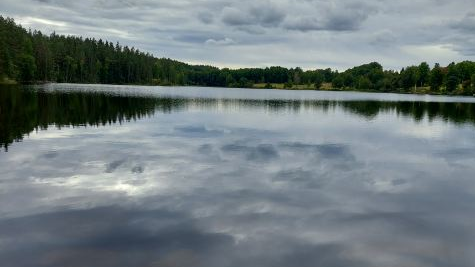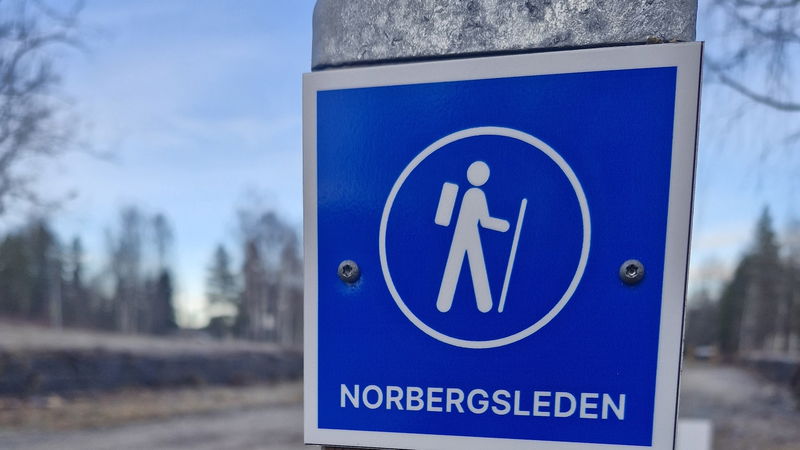Stage 24 is an easy, beautiful and varied route. You walk through a lake-rich landscape past many historic sites. The trail is mostly on forest paths, but there are also smaller gravel roads.
From the exciting mining area at Klackberg, which since 2008 is also a nature reserve, the trail passes over old slag heaps and comes down on a narrow forest road. A railroad used to run here. On the right you see the old platform and the beautiful station house, which today is privately owned.
At Lake Kalven you can turn left from the trail and come down to nice rocks that are well suited for a coffee break, or why not a swim? On the other side of the lake you will soon arrive at the small village of Hinsebo. Here you will find Thorshammar's workshop, an old brass foundry where a living museum of working life is being created.
There is a bathing place at Lake Boten, which you reach after following the Botån river through the forest. From Boten, the trail follows the edge of the lake until you pass Flikån and come out on a small gravel road that you walk on to the stage goal at the beautiful area Fliken. Here is the second bathing place of the stage.
REST AREAS
There is a fireplace at the start of the stage, inside the nature reserve.
At Lake Boten and at Fliken there are nice bathing places. At both places there are changing cabins, tables, benches and TC.
At Lake Kalven it is nice to take a break.
NORBERG
Iron ore and limestone have been mined in the small mining community of Norberg for a long time. There are around 200 mine holes and many other memorials from the heyday of mining. Norberg is the oldest known mining community in Sweden. As early as the Middle Ages, there was a marketplace here where miners from the surrounding villages gathered to buy, exchange and sell supplies. Today, the centuries-old industrial tradition has been broken as all mining has ceased.
In the middle of Norberg is the church and next to it is a bone chamber from the 18th century. Here they collected all the bones that came to light when digging in the cemetery. Nowadays, however, there are no bones here.
The old wooden buildings in Norberg are grouped around the Norbergsån river that flows through the community. Several of the current buildings date from the early 18th and 19th centuries, and some are even older. On the west side of the river is Abrahamsgården, a crafts farm in a 19th-century environment. Here you will find workshops, exhibition rooms and sales of handicrafts from Bergslagen. In the 16th century, Abrahamsgården served as a royal farm and in the 17th century it belonged to Jacob de la Gardie. It has also served as an inn and hostel.
At Kvarngatan 7 you can visit a glassworks. Here, beautiful objects are made from freehand blown glass.
A must when you visit Norberg is to have a coffee at the historic Elsa Anderson's pastry shop. The pastry shop is known far and wide for its environment and its fine pastries. Most famous is the Tango cake.
KLACKBERG
Klackberg is an exciting area with a lot to see in terms of nature and culture. Mining was carried out here for hundreds of years until 1967, which meant that both plants and animals were affected.
Today Klackberg is a nature reserve. Klackberg is home to herb-rich deciduous forest with a large number of elms, and the species-rich shrub layer includes hazel, olivine, woodland rush, tibast and gooseberry. Several orchids grow in the area, including red orchid. There are also wild linden, sweet woodruff, meadow gentian, witch hazel and several species of bracken.
Mount Klacken is at its highest point 200 m above sea level. It was mentioned as early as the 14th century, when it was known as Järnberget. The eastern slope consists mainly of dolomite. Dolomite is a type of limestone and in connection with the limestone there is manganese-containing iron ore. Both iron ore and limestone have been mined in the area and remains of lime kilns can be seen next to Klackbergsgården. The lime was used to facilitate slag formation during smelting. The ore was transported to the smelters in the neighborhood, such as Livsdal, Rosendal and Bråfors.
There are many large and small mine holes to look at. Well worth a visit is Blå Grottan in the southwestern part of the minefield. The Blue Cave is an old adit and shaft. From the gallery flows water that has a clear blue color, hence the name of the cave.
The two round mine lavas, Gröndalslaven and Storgruvans lave, are made of slag and are unique in their kind. Under the lava, there are several hundred meters deep shafts.
The mining environment in Klackberg (Klackbergs Gruvfält) is part of the open-air museum Ekomuseum Bergslagen.
At Klackberg there is today a Winter Stadium with artificial snow facilities. The Engelbrektsspåret ski trail is accessible from the first weekend in December every year. During winter, the Klackbergsbacken is also in full swing! With two slopes and a lift, warming hut and barbecue area, you can have a wonderful snow day on the slopes with family and friends! Klackbergsbacken is also the slope where Olympic gold medalist Frida Hansdotter learned to ski slalom.
FLIKEN
There was a hut in Fliken as early as 1466. By the middle of the 17th century, it was one of the largest in the parish. The plant was closed down in 1888. Today there are remains of the blast furnace, canal structures and slag heaps. At Fliken there is also a manor house from the 1850s.
Take a detour - KÄRRGRUVAN
Kärrgruvan is a "suburb" of Norberg, a village where mining has been going on for hundreds of years. Kärrgruvan's mining environment is part of the open-air museum Ekomuseum Bergslagen.
From Klackberg (stage start) you can instead follow the red markings of the Norbergsleden around Lake Noren to Kärrguvan.
In Kärrgruvan you can walk along the 500 m long path called "Svinryggen" and look at the rows of water-filled mine holes. South of Svinryggen is Mossgruveparken. Here the paths wind their way between precipices and deep water-filled opencast mines. In the area there are facilities left from the end of the 19th century and over the 181 m deep southern shaft there is a wooden shaft from the turn of the century. There is also Risbergs Konstschakt where you can visit a mining museum and learn more about the work in the mines.
The Kärr mine is also home to the Polhem wheel. This water wheel, which was in operation between 1877 and 1920, was built according to Christopher Polhem's principles for extracting water from the mine holes. Previously, water had been brought up by hand and then by draught animals. The water wheel is 15 m in diameter and to it were attached wooden rods that moved back and forth as the wheel spun. The structure could pump water from mines located several kilometers away. The total length of the so-called bar passage is 1.5 km. At the site where the wheel was built, there was no natural power source. Therefore, the water was led via a 3885 m long canal from Lake Bålsjön to the mining area. The water then ran down a channel onto the water wheel.
Where to stay and eat nearby
Read more about where to stay in Norberg here:Stay and eat
SHOP FOR FOOD
Grocery stores are located in the center of Norberg, about 3 km from Klackberg.
READ MORE
Norberg Tourist Guide - Visit Norberg
About Klackberg Nature Reserve - County Administrative Board
Directions
With bus no. 500 you can travel from Norberg to Fagersta - Skinnskatteberg - Köping and to Avesta.
You can't use public transport to Fliken, but bus no. 85 runs between Kärrgruvan (2 km southeast of Fliken) and Norberg both on weekdays and weekends.
If you drive, you can park at Klackberg.






